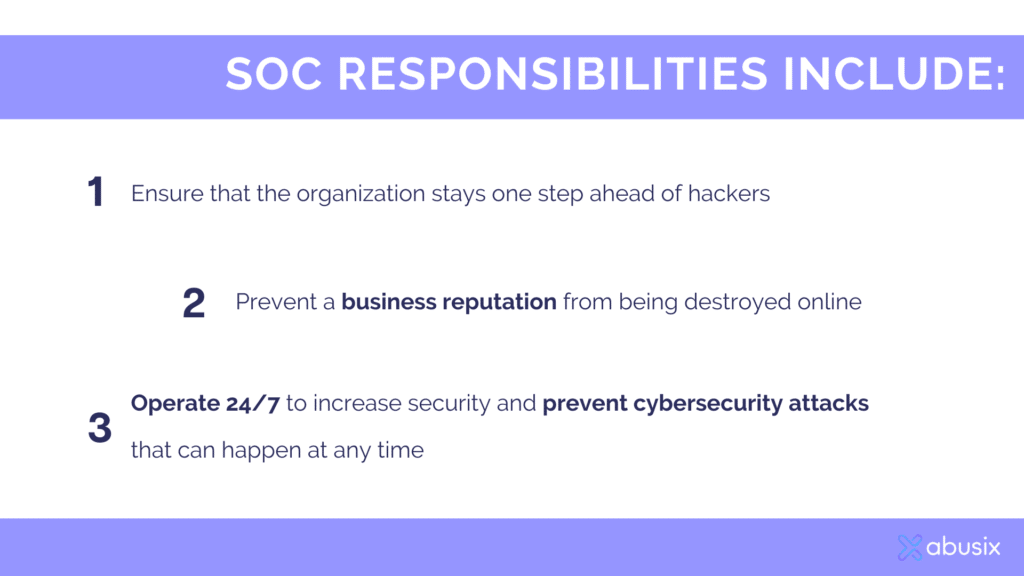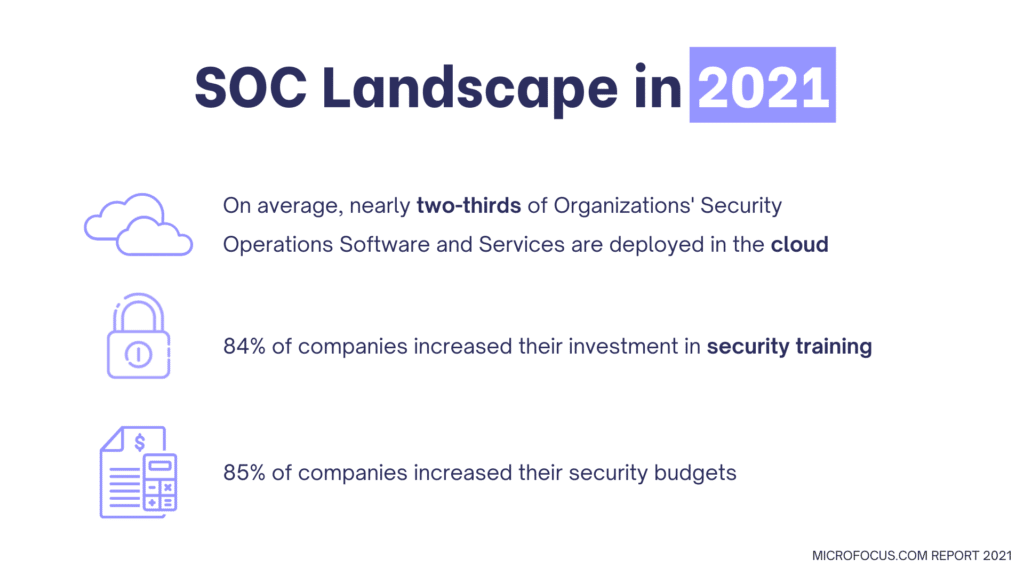Cyberattacks are on the rise and data breaches are becoming more and more frequent.
Even the most sophisticated companies struggle with protecting their data.
One way to help ensure that your company stays protected is by establishing a Security Operations Center (SOC).
Security Operations Centers are the frontline of cyberdefense nowadays and many firms rely on them to react to threats.
In this article, we’ll discuss:
- What is a SOC?
- Why should you consider implementing a SOC?
- What types of threats can SOCs help minimize?
- What is the right call for your company: an in-house SOC or an outsourced SOC?
What is a Security Operations Center (SOC)?
Typically, that team will be responsible for all IT issues that occur at a firm, whether they happen to be cybersecurity threats or setting up a VPN.
However, a Security Operations Center differs from a traditional IT department.
A SOC is a group of IT security professionals that monitor, detect, analyze and investigate cyber threats.
SOCs are extremely specialized, unlike a traditional IT department.

Cyberattacks can be devastating for a number of reasons.
For example, Russian cyberattacks against Ukraine have demonstrated how cybersecurity is at the forefront of a proper defense.
Cyberattacks often don’t just impact countries either. Many businesses can be targeted by either state actors or rogue hacker groups.
As dangerous cybersecurity threats become more prominent, understanding that a SOC is right for you is essential.
What are the benefits of implementing a SOC?

At first glance, a SOC might sound like an unnecessary expense, but let’s take a look at some of the benefits:
- A SOC gives you a dedicated team of experts that can respond to threats immediately. This means that when an attack occurs, you can respond instantly.
- A SOC can also help you develop a defense plan, that way you’ll be better protected and be able to repel any attacks that do occur.
- Finally, a SOC can mitigate any potential damage that can come from an attack.
How Do SOCs Work?
How does a SOC achieve these benefits?
The main goal of your SOC will be to monitor your security and alert you to any potential dangers.
In order to achieve this, SOCs collect massive amounts of data regarding your organization to understand how threats may attack.
Many SOCs utilize special software and threat intelligence, like Abusix, in order to analyze this data.
Typically, SOCs will monitor hardware and software. Then when threats, discrepancies, or abnormal trends appear, they will jump into action.
Abusix Mail Intelligence is an advanced threat protection filter that adds real-time threat data to your existing security solution, while protecting you from phishing and other email-borne threats
What do SOCs Do?
The work in a SOC typically involves a number of actions.
The data collection and monitoring are sometimes called asset discovery. This means that a SOC builds a deep understanding of all the technologies used in the organization and then monitors these technologies for security issues.
This monitoring is called “behavior monitoring.”
This means that the SOC is checking all systems and infrastructure for potential abnormalities.
Additionally, suspicious activity is also monitored. This means employees accessing suspicious websites, or downloading unnecessary software.
Understanding network activities and communications are also important for a company’s SOC.
Tracking email and other sources of communication are key for ensuring that the company is secure. Furthermore this tracking loops back into behavioral monitoring principles.
As you can see much of a SOCs work is actually preventative in nature.
However, if and when an incident occurs the SOC will jump into action and take active measures. This part is known as incident response. Incidence response refers to any sort of security compromise that occurs.
An incident can range from a full-blown attack to a security hole being discovered. The SOC then ranks incidents as they occur, investigates them, and then determines their root cause. These steps help ensure that the incident does not repeat and prevent hackers from breaking into your network using backdoors.
Lastly, a SOC can also help your organization maintain regulatory compliance. By using AI technologies to monitor network traffic, your SOC can alert you to potential regulatory violations that may occur when sensitive data is shared with the wrong people.
SOCs play a vital role in protecting the integrity of your organization and ensuring that sensitive data does not fall into the wrong hands.
How to correctly implement a SOC
Before you jump into creating a SOC it’s important to make sure that it is properly implemented.
Careful planning is required to properly implement a SOC. This way, your SOC will be able to be effective and a valuable asset to your firm.
Here are the steps to do it:
- Develop a cybersecurity strategy
- Analyze business objectives and challenges
- Consider outsourcing vs in-house when analyzing your business objectives and challenges
Develop a cybersecurity strategy
Before embarking on creating a SOC your company should have a clearly established cybersecurity strategy. Without understanding this key component, you’ll be unsure where to even begin with establishing a SOC. There is no one-size-fits-all solution for a SOC. So, the goals and structure of your SOC will largely depend on your company’s goals.
Analyze business objectives and challenges
In order to build your cybersecurity strategy, you’ll need to understand your business objectives and challenges. As stated before, not all SOCs are the same, and neither are all businesses. The goals and challenges of your business will determine what type of cybersecurity strategy you should build.
Consider outsourcing vs in-house when analyzing your business objectives and challenges
Finally, determine whether your business should build a SOC from the ground up or outsource a SOC. Smaller firms and companies may be unable to support the infrastructure necessary to have their own in-house SOC. On the other hand, a larger company may use specially-developed cloud-based microservices that necessitate an in-house SOC to understand the particular vulnerabilities your company faces.
SOCs can benefit companies and help protect your data
Cyberattacks remain one of the most vicious ways bad actors can disrupt your company today.
For example, Toyota recently experienced a supply chain shut down as a result of one of these attacks.
Organizations, whether they are large or small, all have sensitive data that they need to protect.
Cybersecurity is something that all managers need to consider as important. Increasingly, offices and businesses have shifted from being paper-based to being cloud-based and online.
Whether your company decides to use in-house teams or outsource the work, software and tools, like Abusix, can be helpful to protect your organization and its data.




